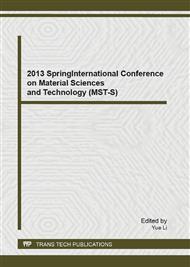[1]
B.B. Aggarwal , A. Bhardwaj, R.S. Aggarwal, N.P. Seeram, S. Shishodia, Y. Takada, Role of resveratrol in prevention and therapy of cancer: preclinical and clinical studies, Anticancer Res. 24(5a) (2004) 2783-2840.
Google Scholar
[2]
S. Shankar, G. Singh, R.K. Srivastava, Chemoprevention by resveratrol: molecular mechanisms and therapeutic potential, Front Biosci. 12 (2007) 4839-4854.
DOI: 10.2741/2432
Google Scholar
[3]
J.S. Chang, H.W. Liu, K.C. Wang, M.C. Chen, L.C. Chiang, Y.C. Hua, C.C. Lin, Ethanol extract of Polygonum cuspidatum inhibits hepatitis B virus in a stable HBV-producing cell line, Antiviral Res. 66(1) (2005) 29-34.
DOI: 10.1016/j.antiviral.2004.12.006
Google Scholar
[4]
H.Z. Zheng, Z.H. Dong, J. She, H. Zhang, Rhizoma polygoni cuspidate, in: modern study of traditional Chinese Medicine, vol. 3, Xue Yuan Press, Beijing, 1998, p.2800
Google Scholar
[5]
X. Chu, A. Sun, R. Liu, Preparative isolation and purification of five compounds from the Chinese medicinal herb Polygonum cuspidatum Sieb. et Zucc by high-speed counter-current chromatography, J. Chromatogr. A 1097 (2005) 33-39.
DOI: 10.1016/j.chroma.2005.08.008
Google Scholar
[6]
L. Chen, Y.H. Han, F.Q. Yang, T.Y. Zhang, High-speed counter-current chromatography separation and purification of resveratrol and piceid from polygonum cuspidatum, J. Chromatogr. A 907 (2001) 343-346.
DOI: 10.1016/s0021-9673(00)00960-2
Google Scholar
[7]
F.Q. Yang, T.Y. Zhang, Y.C. Ito, Large-Scale separation of resveratrol, anthraglycoside A and anthraglycoside B from polygonum cuspidatum Sieb. Et Zucc by high-speed counter-current chromatography, J Chromatogr. A 919 (2001) 443-448.
DOI: 10.1016/s0021-9673(01)00846-9
Google Scholar
[8]
J.C. Zhang, L.J. Gao, Purificaiton of resveratrol by simulated moving bed chromatography, Chinese Journal of Spectroscopy Laboratory 29 (2012) 150-152.
Google Scholar
[9]
J.C. Zhang, L.J. Gao, Pretreatment of raw materials for purification of resveratrol by simulated moving bed chromatography, Chinese Journal of Spectroscopy Laboratory 28 (2011) 1763-1766.
Google Scholar
[10]
H.M. Lu , W.D. Ni, Y.Z. Liang, R.L. Man, Supercritical CO2 extraction of emodin and physcion from Polygonum cuspidatum and subsequent isolation by semipreparative chromatography, J. Sep. Sci. 29 (2006) 2136-2142.
DOI: 10.1002/jssc.200600012
Google Scholar
[11]
W.D. Ni, R.L. Man, L.Y. Li, X.Y. Ji, R.X. Shi, S.Q. Yang, S. Zhang, Study on the supercritical carbon dioxide extraction effective constituents from Chinese herb Polygonum cuspidatum, Chemical Engineer 132 (2006) 3-7 (in Chinese).
Google Scholar
[12]
W.L. Yu, , B. Shu, Y.P. Zhao, Supercritical CO2 extraction of resveratrol and its glycoside piceid from Chimese Traditional Medicinal Herb Polygonum cuspidatum, J. Sci. Food Agric., 85 (2005) 489-492.
DOI: 10.1002/jsfa.2007
Google Scholar
[13]
B. Benova, M. Adam, P. Pavlikova, J. Fischer, Supercritical Fluid Extraction of Piceid, resveratrol and emodin from Japanese knotweed, J. Supercrit. Fluids 51 (2010) 325-330.
DOI: 10.1016/j.supflu.2009.10.009
Google Scholar
[14]
A. Rajendran, G. Paredes, M. Mazzotti, Simulated Moving Bed Chromatography for the Separation of Enantiomers, J Chromatogr. A 1216 (2009) 709-738.
DOI: 10.1016/j.chroma.2008.10.075
Google Scholar
[15]
H. Schmidt-Traub (Eds.), Preparative Chromatography of Fine Chemicals and Pharmaceutical Agents, Wiley-VCH Verlag GmbH & Co., KGaA, Weinheim, 2005.
DOI: 10.1002/3527603484
Google Scholar
[16]
G. Subramanian, Chiral Separation Techniques – A Practical Approach, 2nd ed., Wiley-VCH, Verlag GmbH & Co. , KGaA, Weinheim, 2001.
DOI: 10.1021/ja076917g
Google Scholar
[17]
M.T. Liang, R.C. Liang, L.Y. Wang, H.E. Yen, K.T. Lee, Effect of Temperature Variation on the Separation of Sesamin and Sesamolin by Simulated Moving Bed, J. Chem. Chem. Eng. 5(6) (2011) 479-786.
Google Scholar
[18]
J.X. Cong, B.C. Lin, Separation of Liquiritin by simulated moving bed chromatography, J Chromatogr. A 1145 (2007) 190-194.
DOI: 10.1016/j.chroma.2007.01.088
Google Scholar
[19]
F. Wei, Y.X. Zhao, Separation of capsaicin from capsaicinoids by simulated moving bed chromatography, J Chromatogr. A 1187 (2008) 281-284.
DOI: 10.1016/j.chroma.2007.12.081
Google Scholar
[20]
M.T. Liang, R.C. Liang, L.R. Huang, P.H. Hsu, Y.H. Wu, H.E. Yen, Separation of Sesamin and Sesamolin by a Supercritical Fluid-Simulated Moving Bed, Am. J. Anal. Chem. 3 (2012) 931-938.
DOI: 10.4236/ajac.2012.312a123
Google Scholar
[21]
P.J. Dunn, A.S. Wells, M.T. Williams (Eds.), Green Chemistry in the pharmaceutical industry, Wiley-VCH, Verlag GmbH & Co. , KGaA, Weinheim, 2010.
Google Scholar
[22]
M.T. Liang, R.C. Liang, H.F. Hsu, J.Y. Houng, Separation of Bioactive Ingredients from Glossogyne tenuifolia Extract by Simulated Moving Bed, The International Conference on Process Intensification for Sustainable Chemical Industries (ICPI 2011), June 26-29, 2011, Beijing, China
Google Scholar
[23]
M.T. Liang, R.C. Liang, K.Y. Liang, Separation of Triterpenoids from Taiwanofugus camphorata by Supercritical Fluid Extraction and Simulated Moving Bed, 10th Conference on Supercritical Fluids and Their Applications, April 29-May 06, 2013, Naples, Italy
DOI: 10.1016/j.jtice.2013.10.013
Google Scholar
[24]
M.T. Liang, R.C. Liang, L.R. Huang, K.Y. Liang, Y.L. Chien, J.Y. Liao, Supercritical Fluids as the Desorbent for Simulated Moving Bed – Application to the Concentration of Triterpenoids from Taiwanofugus camphorata, 14th International Symposium on Preparative and Industrial Chromatography and Allied Techniques (SPICA 2012), September 30-October 3, 2012, Brussels, Belgium
DOI: 10.1016/j.jtice.2013.10.013
Google Scholar


